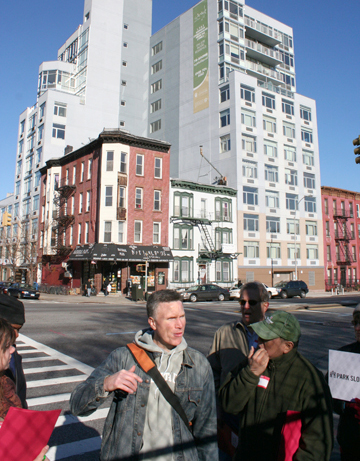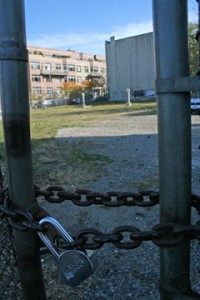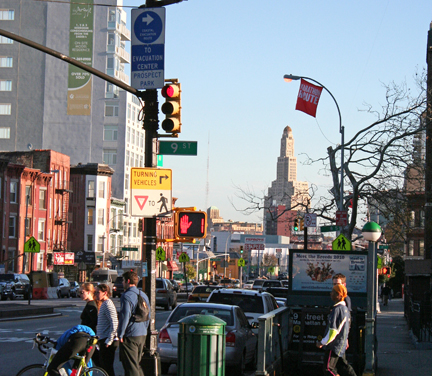Standing on the southeast corner of Fourth Avenue and Ninth Street, you can see some of the changes that have taken place on this part of Park Slope and imagine others in the not-too-distant future. Countdown timers on the lampposts there tick down the seconds until it’s safe to cross the heavily trafficked street. Construction of a residential building is underway a couple of blocks away, while newly completed towers dot the landscape. Across the street, the Metropolitan Transportation Authority has posted signs detailing some station improvements on the F line. The corner thus became an ideal meeting point for a walk to learn more about these developments and envision what could lie ahead.
Some 40 people came along for this Park Slope Civic Council-led walk, called “Moving Forward on Fourth,” on the crisp fall morning of Nov. 6. Experienced members of the community shared their knowledge with participants at 10 stops along the way and discussed a range of ideas for the thoroughfare.
The event was an outgrowth of the Civic Council’s March forum, “The Future of Fourth Avenue,” and furthers the Council’s efforts to engage neighbors in the avenue’s future. “The most important message to take away from the walkabout is if you’re interested in making Fourth better, now’s the time to be proactive, to get involved,” said Josh Levy, Civic Council trustee and an organizer of the walkabout. “To complain after the fact would be less effective.”
Levy noted that people on the walk were mainly concerned about three issues: the need for greater pedestrian safety, a change in the increasing development of the area so as to encourage more retail and other activities at street level, and the greening and beautification of this lengthy boulevard. Each stop addressed at least one of those concerns.
The first place for discussion touched on all three: the currently closed subway entrance on the east side of the Fourth Avenue/Ninth Street station. That entryway has been closed for about 25 years, and has become somewhat of an eyesore under the elevated station. The rapid growth of Fourth Avenue and environs has meant a lot more people use the station and often cross busy, sometimes dangerous Fourth Avenue traffic to get to the F train.
“We’re interested in getting New York City Transit to reopen this entrance, a full MetroCard entrance with security cameras, rather than having everyone cross the street,” said Civic Council President Michael Cairl, who led the discussion at this stop. The Council’s initiative here has spurred action from the agency, which is now looking at rehabilitating both sides of the station, opening the retail space near the entrance for lease, and reopening access to the entry from 10th Street to generate more foot traffic.
“This is a very exciting thing,” Cairl said. “We’re very encouraged that local elected officials are working with us, and that New York City Transit is committed to this, too.” Transit officials will present their plans at the Civic Council’s Trustees meeting in January 2011.
Efforts to make the avenue safer for pedestrians and all users were in evidence throughout the walk. The countdown timers at the intersection of Fourth Avenue and Ninth Street, for example, are the first local step in the city Department of Transportation’s Safe Streets Initiative. More timers will soon be installed along the corridor from Flatbush Avenue to 65th Street, an important safety measure on one of the most dangerous roadways in the city.
Levy talked about the recent changes at Union Street. Larger traffic medians, enlarged corners known as bulb-outs, and no left turn for northbound traffic all help make crossing Fourth here less risky. He also discussed possible ideas for the intersection, ranging from on-street bike parking at the southeast corner of the intersection, which could increase visibility for all users, to a gateway that would welcome drivers to the neighborhood and to slower residential streets.
Another topic of concern was development and the opportunity for retail and street-level activity along Fourth Avenue. Many residential buildings that have risen along Fourth were built according to a zoning agreement that prevented large new structures east of Fourth but allowed for larger buildings on both sides of the avenue.
That zoning arrangement said nothing about what should be placed on the street front of these larger buildings. In addition, many of these residences were required to have on-site parking. Developers thus had to fit a large lobby entrance, a parking garage, and room for mechanicals at ground level, leaving little space for retail that wasn’t mandatory anyway. The Argyle at Seventh Street, for example, is nothing but a parking garage and vents on its Fourth Avenue side.
“This is the kind of building we hope never to see again,” Levy said. “We can work together to make our feelings known ahead of time to prevent this type of development in the future.” Developers often present their plans at Civic Council meetings, giving the community opportunity to weigh in on such design matters.
One nearby retail development generated a great deal of discussion: the plans for a large Whole Foods Market at Third Avenue and Third Street. The popular supermarket chain announced their intention to build a 64,000-square-foot store at that intersection six years ago. (About 85% of the market will be built below grade.) Remediation for toxic sludge on the site was completed a few months ago, so the company may soon be moving forward with development.
The most recent design for the store includes a 420-car parking garage on top of the building. According to Civic Council Treasurer Eric McClure, that number is derived from models used for the chain’s suburban stores; a recently opened store in Darien, Conn., where 97% of residents own cars, has a similarly sized parking lot. (Car ownership in Park Slope is around 40%.) A garage that size would bring approximately 540,000 new car trips into the community each year, McClure noted, two-thirds the volume expected to be generated by Atlantic Yards.
Park Slope Neighbors, the group McClure co-founded, launched a campaign after meetings with Whole Foods in 2006 to get the company to rethink the plan and transportation around the store, and shrink the garage by about 120 spaces. McClure cited other examples of nearby stores that thrive without much parking — the Fairway Market in Red Hook, whose 300-spot lot is usually only two-thirds full in a neighborhood poorly served by mass transit; and the Park Slope Food Coop, which succeeds with very little parking. Whole Foods stores in Manhattan have almost no onsite parking.
“Whole Foods has thus far rebuffed any outreach from Park Slope Neighbors and the Civic Council,” he said. “We encourage them to work with the community more, and help come up with more options than driving.” According to McClure, Assemblymember Joan Millman said an announcement should be coming soon concerning the next phase of the project.
Renovations in Washington Park, the Old Stone House, and J.J. Byrne Playground [is that what it’s still called?] — the largest green space in the immediate vicinity — marked another key spot on the walk. The Old Stone House has become a center for educational programming on Brooklyn history and the local environment. The organization has also helped drive renovation of its surroundings, which has led to a new artificial turf field in a renewed Washington Park. The project “really made the house more accessible from Third and Fourth Avenues,” said Old Stone House Executive Director Kim Maier, “which has increased access and helped create a ‘town square’ feel for neighbors all around the park.”
The next phase of renovation here will be in the playground space from Fifth Avenue to the house, which will increase play area by about 65%, allow for separate spaces for younger and older kids, and include a new garden with native plants. Further into the future, Maier is aiming for another building in the park that would offer new community meeting spaces, park storage, and restrooms, removing those facilities from the Old Stone House so as to open up more gallery and educational spaces there.
Maier also talked about the effort to close off the Fourth Street cul-de-sac next to the park to most traffic and convert it into a play street. The Old Stone House, the Civic Council, and City Councilmember Brad Lander have worked on plans to remove traffic from the street, find new parking spots for M.S. 51 teachers nearby, and turn the street into a mixed-use public plaza.
The Department of Transportation “has been very open to the idea,” said Maier. “It would be an amazing plaza space, and would be safer for the school, make for a new play space while the playground’s under reconstruction, and give more space for the farmer’s market on Sunday.”
The final stop of the Moving Forward on Fourth walk was on Sackett Street. The now-empty lot on the southeast corner is owned by the city’s Department of Environmental Protection and provides access to the Third Water Tunnel, still under construction after several decades. Fifteen years ago, community residents formed the group GreenSpace to get a needed park built on that space. Using funds from the Percent for Art program, the organization hired sculptor Meg Webster to develop a park planThe result, finished three years ago, covered the complete site, and included water features, a walkway, and an amphitheater.
Even with several revisions, “every time the plan was presented, DEP said they needed access to the tunnel [even after it was completed],” said community gardener and GreenSpace organizer Judy Janga, and they had concerns about safety and security on the site. DEP has scheduled a meeting next May with GreenSpace and Community Board 6 to discuss the issue. The Civic Council, Levy noted, hopes to work with all of these groups to get a park or garden moving forward.
After the walk, many people gathered at Zora Space Cafe on Fourth Avenue near Third Street to further discuss these topics. They also talked about changes to zoning requirements, schools in the area, and flooding. Comment cards with even more issues of concern were collected.
So what’s next? “All the comments, questions, and data will be compiled into a final report that will be presented to local policymakers,” said Levy. “Using the information in that report, we’ll work with local developers and other key figures to see what we can do to improve the situation on Fourth Avenue.”
Photographs by David Herman; see more of my photo work for the Park Slope Civic Council in this portfolio.
Portfolio(s): Editorial
Project type: Community Outreach, Writing and Reporting
Posted: November 2010



